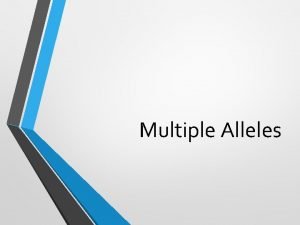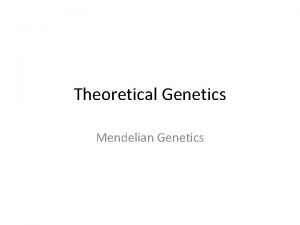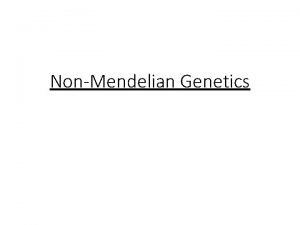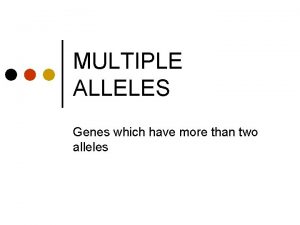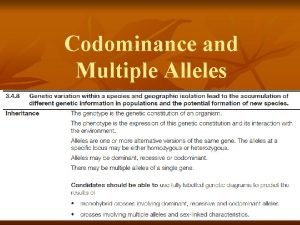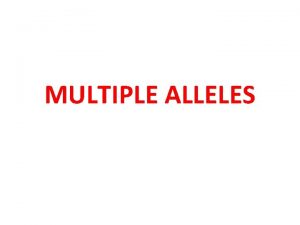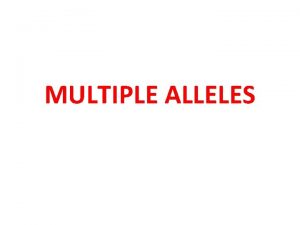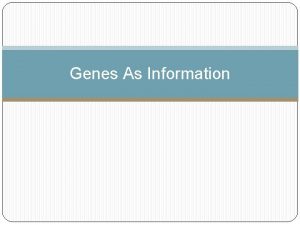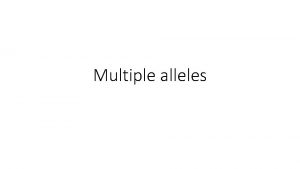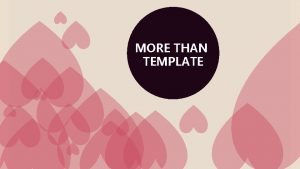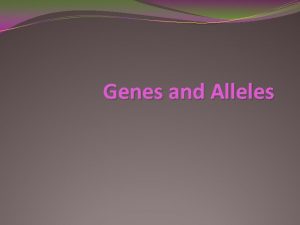MULTIPLE ALLELES Genes that have more than two











- Slides: 11

MULTIPLE ALLELES Genes that have more than two alleles © 2016 Paul Billiet ODWS

Genes and their alleles ¢ ¢ ¢ About 30% of the genes in humans are diallelic They exist in two forms, (they have two alleles) About 70% are mono-allelic, they only exist in one form and they show no variation A few are poly-allelic having more than two forms. © 2016 Paul Billiet ODWS

Combinations ¢ ¢ Di-allelic genes can generate 3 genotypes AA, Aa and aa Genes with 3 alleles can generate 6 genotypes (3+2+1) Genes with 4 alleles can generate 10 genotypes (4+3+2+1) Genes with 8 alleles can generate 36 genotypes. © 2016 Paul Billiet ODWS

Genes and the immune system ¢ ¢ Poly-allelic genes associated with tissue types Genes so varied they provide us with our genetic finger print Important for our immune system self and non-self. © 2016 Paul Billiet ODWS

The ABO blood system ¢ ¢ ¢ ¢ Controlled by a tri-allelic gene 6 genotypes The alleles for antigens on the surface of the red blood cells Two of the alleles are codominant to one another and both are dominant over the third Allele IA produces antigen A Allele IB produces antigen B Allele i produces no antigen. © 2016 Paul Billiet ODWS

The ABO blood system Genotypes IA I A IA I B IA i IB IB IB i ii Phenotypes (Blood types) A AB A B B O Note: ¢ Blood types A and B have two possible genotypes – homozygous and heterozygous ¢ Blood types AB and O only have one genotype each. © 2016 Paul Billiet ODWS

Blood types and transfusions Blood types vary and your immune system recognises your own blood type = self ¢ Other blood types = non-self ¢ If a blood, which is incompatible with your body, is transfused it will result in the agglutination of the foreign red blood cells. ¢ © 2016 Paul Billiet ODWS

Antigens encarta. msn. com/. . . /Erythrocytes. html © 2016 Paul Billiet ODWS www. okc. cc. ok. us/. . . /Plasma_Membrane. htm

Agglutination www. vet-lyon. fr/. . . /ENV_immuno_1 A/immun 1 -04. htm. © 2016 Paul Billiet ODWS

Blood types and transfusions ¢ ¢ Type A people produce antibodies to agglutinate cells which carry Type B antigens Recognised as non-self The opposite is true for people who are Type B Neither of these people will agglutinate blood cells which are Type O cells do not carry antigens for the ABO system Type O cells pass incognito What about type AB people? © 2016 Paul Billiet ODWS

Donor-recipient compatibility Recipient Type A B AB O A Donor B AB O = Agglutination = Safe transfusion © 2016 Paul Billiet ODWS Note: ¢ Type O blood may be transfused into all the other types = the universal donor ¢ Type AB blood can receive blood from all the other blood types = the universal recipient.
 Lirik lagu more more more we praise you
Lirik lagu more more more we praise you More more more i want more more more more we praise you
More more more i want more more more more we praise you Ao+ blood type
Ao+ blood type Linked genes and unlinked genes
Linked genes and unlinked genes What are homeotic genes
What are homeotic genes Polygenic inheritance
Polygenic inheritance Multiple alleles example blood type
Multiple alleles example blood type Step two
Step two Genetic probability chart
Genetic probability chart Codominance example
Codominance example Multiple alleles genotypes
Multiple alleles genotypes Sickle cell anaemia
Sickle cell anaemia


